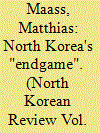| Srl | Item |
| 1 |
ID:
165782


|
|
|
|
|
| Summary/Abstract |
Article Type: Commentary Essay Purpose—Much of the debate on North Korea assumes that Pyongyang would be truly satisfied with the overall status quo if it were only safe and secure enough. The purpose here is to argue that Pyongyang may instead be looking for reunification from a position of strength. Method—The short paper is built mostly on secondary-source research. It uses short historical case studies in addition to professional writings, both academic and journalistic. Findings—Overall, the argument is that Pyongyang has never abandoned the goal of unifying the peninsula under its own leadership. In fact, its "endgame" is a DPRK that spans the entire peninsula and unites the entire Korean people. Implications—To go forward and work with a nuclear North Korea towards a mutually agreeable long-term arrangement on the peninsula, understanding the long-term goals of Kim Jong Un is critical. The argument presented here may instill more caution in negotiation partners and statesmen/-women, especially in Seoul, Washington, and Tokyo, but also in Beijing and Moscow.
|
|
|
|
|
|
|
|
|
|
|
|
|
|
|
|
| 2 |
ID:
148676


|
|
|
|
|
| Summary/Abstract |
Digital games are among the most popular forms of entertainment media. Despite their ubiquity, the fields of political science, International Relations, and political communication have generally overlooked the study of digital games. We take up this void by examining the international enemies depicted in combat games – specifically, first-person shooter (FPS) games – which can speak to the process in the construction of international threats in society. Our review of framing the enemy gleans perspectives from multiple disciplines including International Relations, political communication, and digital gaming. Our empirical analysis traces the evolution of images in digital games from 2001 to 2013 to reveal the identity of the enemies and protagonists and to examine the context of the game – including the setting where each game takes place. We find that Russians are a popular form of enemy in FPS games even after considering terrorists as a broad category. Our review of the literature and our empirical analysis together present a foundation for the future study of digital games as a process of framing of enemies and transmission of threats.
|
|
|
|
|
|
|
|
|
|
|
|
|
|
|
|